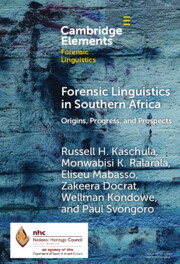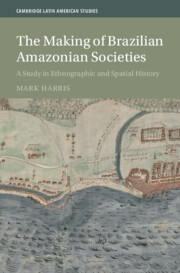Refine search
Actions for selected content:
1399 results
5 - Conclusions, Reflections
-
- Book:
- From Mutiny to Revolt
- Published online:
- 26 November 2025
- Print publication:
- 18 December 2025, pp 179-193
-
- Chapter
- Export citation
2 - A Walk through Heyang
-
- Book:
- Homesick Nation
- Published online:
- 20 November 2025
- Print publication:
- 18 December 2025, pp 29-61
-
- Chapter
- Export citation
Afterword
-
- Book:
- Irish Romanticism
- Published online:
- 27 November 2025
- Print publication:
- 11 December 2025, pp 164-181
-
- Chapter
- Export citation
Introduction
-
- Book:
- Irish Romanticism
- Published online:
- 27 November 2025
- Print publication:
- 11 December 2025, pp 1-25
-
- Chapter
- Export citation
Chapter 2 - Getting a Life
- from Part I - How Research on Autobiographical Memory Contrasts with and Integrates the Life Story Approach
-
-
- Book:
- Autobiographical Memory and the Life Story
- Published online:
- 20 November 2025
- Print publication:
- 04 December 2025, pp 9-33
-
- Chapter
- Export citation

Forensic Linguistics in Southern Africa
- Origins, Progress, and Prospects
-
- Published online:
- 25 November 2025
- Print publication:
- 18 December 2025
-
- Element
-
- You have access
- Open access
- HTML
- Export citation

Maddalena Casulana
- Music Advocating for Women in Early Modern Italy
-
- Published online:
- 20 November 2025
- Print publication:
- 04 December 2025

Knowledge and Narrative
-
- Published online:
- 18 November 2025
- Print publication:
- 18 December 2025
-
- Element
-
- You have access
- HTML
- Export citation
Women in Political Science: A History of the Canadian Political Science Association’s Women’s Caucus
-
- Journal:
- Canadian Journal of Political Science/Revue canadienne de science politique , First View
- Published online by Cambridge University Press:
- 18 November 2025, pp. 1-22
-
- Article
-
- You have access
- Open access
- HTML
- Export citation
Rethinking the Marshall-Cases ‘from below’: Helen Marshall as a legal entrepreneur in Southern England and Luxembourg, 1978–1993
-
- Journal:
- European Law Open / Volume 4 / Issue 3 / September 2025
- Published online by Cambridge University Press:
- 18 November 2025, pp. 553-573
-
- Article
-
- You have access
- Open access
- HTML
- Export citation

The Making of Brazilian Amazonian Societies
- A Study in Ethnographic and Spatial History
-
- Published online:
- 14 November 2025
- Print publication:
- 20 November 2025
Chapter 10 - Recalling Colonialism in North Africa
- from Part II - Memories
-
-
- Book:
- African Literature in Transition
- Published online:
- 31 October 2025
- Print publication:
- 13 November 2025, pp 152-167
-
- Chapter
- Export citation

Race, Genetics, History
- New Practices, New Approaches
-
- Published online:
- 11 November 2025
- Print publication:
- 11 December 2025
-
- Element
-
- You have access
- HTML
- Export citation
Rethinking European legal integration: legal text from a bottom-up perspective and the functioning of European law, 1957–2000
-
- Journal:
- European Law Open / Volume 4 / Issue 3 / September 2025
- Published online by Cambridge University Press:
- 10 November 2025, pp. 505-517
-
- Article
-
- You have access
- Open access
- HTML
- Export citation

Cultural Property
- Law, Policy, and Markets
-
- Published online:
- 05 November 2025
- Print publication:
- 30 October 2025
Chapter 4 - Bloomsbury and the New Biography
- from Part I - Aesthetic Bloomsbury
-
-
- Book:
- A History of the Bloomsbury Group
- Published online:
- 09 October 2025
- Print publication:
- 23 October 2025, pp 52-67
-
- Chapter
- Export citation
7 - Reception and Legacy
-
- Book:
- Donizetti: Lucia di Lammermoor
- Published online:
- 06 November 2025
- Print publication:
- 23 October 2025, pp 156-176
-
- Chapter
- Export citation
Chapter 10 - Bloomsbury and the USA
- from Part II - Global Bloomsbury
-
-
- Book:
- A History of the Bloomsbury Group
- Published online:
- 09 October 2025
- Print publication:
- 23 October 2025, pp 155-170
-
- Chapter
- Export citation
The Apostle Sculptures of Yorkshire, St Wilfrid’s Episcopal Mission and his Cult: Aspects of Ecclesiastical Conflicts in Northumbria from the Late Seventh to Early Ninth Centuries
-
- Journal:
- Early Medieval England and its Neighbours / Volume 51 / 2025
- Published online by Cambridge University Press:
- 17 October 2025, e14
-
- Article
-
- You have access
- Open access
- HTML
- Export citation
2 - Literary Form
- from Part I - First Principles: What Is a Gospel, According to Origen?
-
- Book:
- The Life of Jesus in the Writings of Origen of Alexandria
- Published online:
- 26 September 2025
- Print publication:
- 16 October 2025, pp 17-37
-
- Chapter
- Export citation
